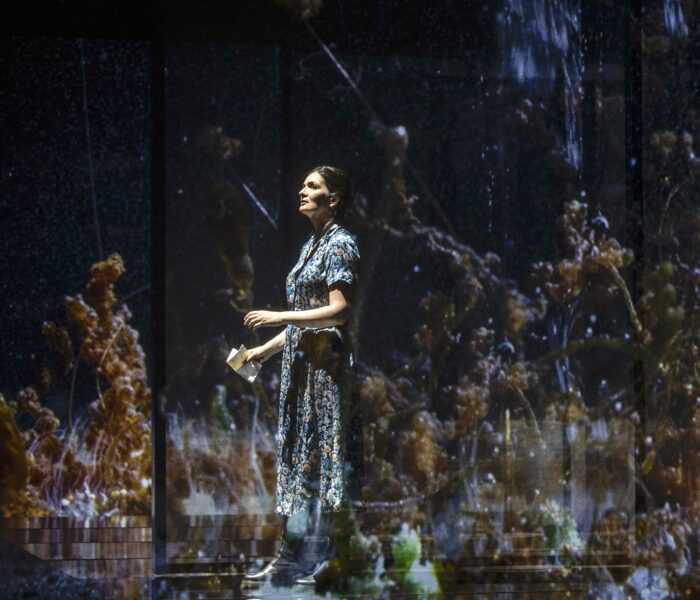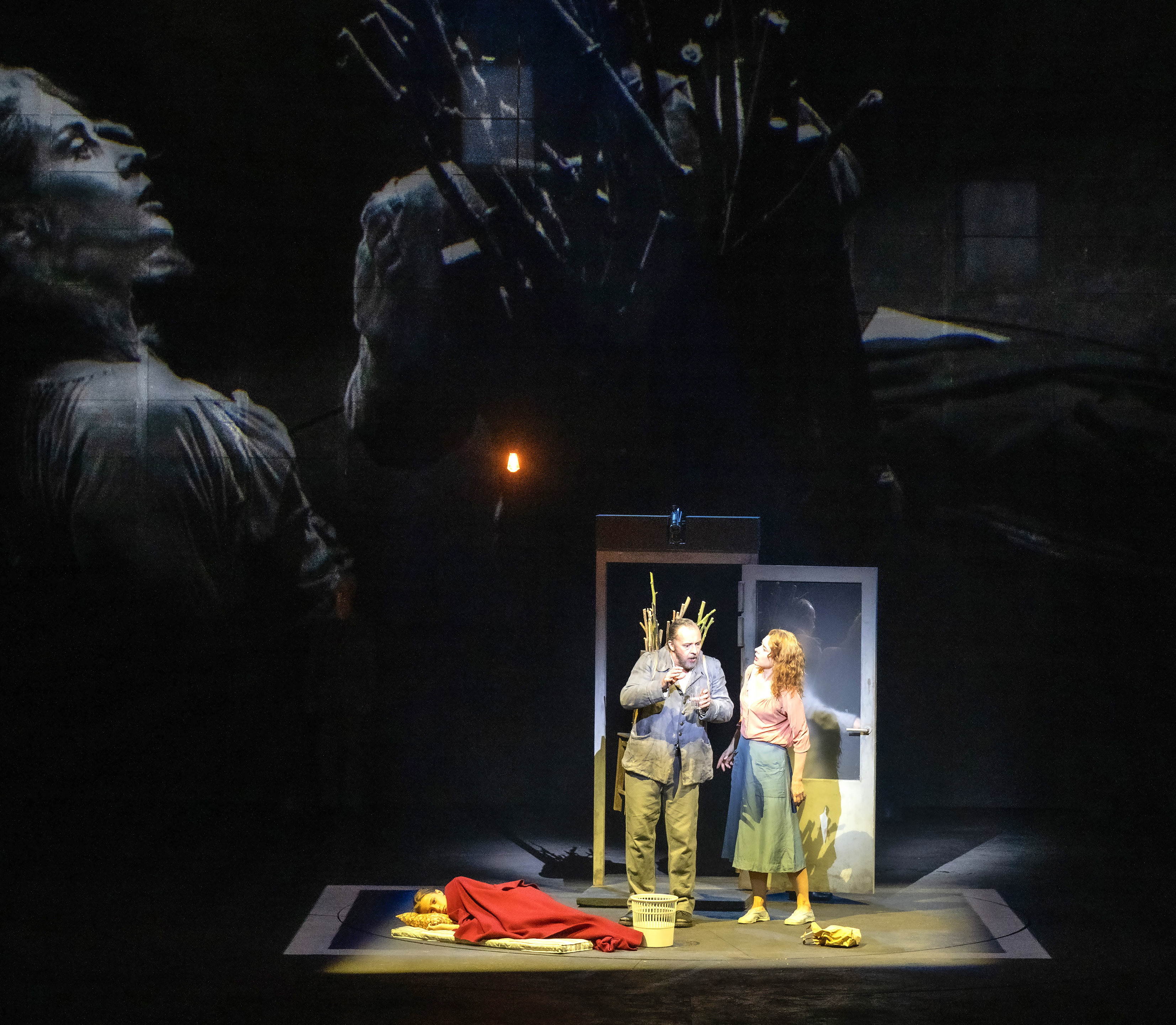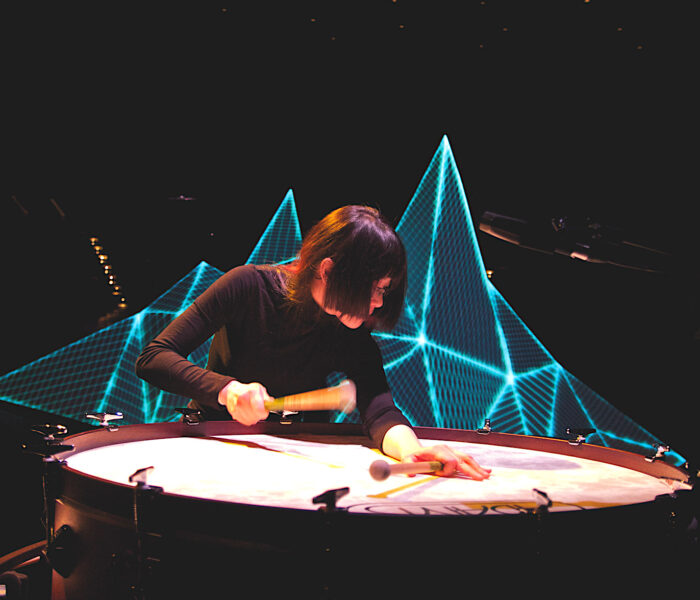Véritable thriller maintenant le suspens jusqu’au bout, Innocence, le cinquième opéra de la compositrice finlandaise Kaija Saariaho donné en création mondiale au Grand Théâtre de Provence vit au rythme et au souffle de la tragédie antique et nous bouleverse.
Festival d’Aix-en-Provence, jusqu’au 12 juillet.
L’opéra en cinq actes et vingt-cinq scènes sans entracte (1 heure 40 de musique) repose sur le livret original en finnois que la compositrice commande à l’écrivaine finlandaise Sofi Oksanen. Il met en scène treize personnages et croise deux niveaux de narration qui vont peu à peu s’imbriquer l’un dans l’autre : un banquet de noces en famille à Helsinki dans les années 2000 où a été engagée en extra la serveuse Teresa, d’une part, et le contexte d’un drame d’autre part, une fusillade dans un établissement secondaire qui s’est passé, il y a dix ans de cela, dans un lycée international où la fille de Teresa, Markéta, a trouvé la mort.
Kaija Saariaho dit avoir eu en tête la toile de Léonard de Vinci, La Cène, où le Christ entouré de ses douze apôtres lors du dernier repas scrute le visage de chacun d’eux pour cherche le coupable. Le thème est central– « tout le monde est coupable, toujours, à sa manière » – dans Innocence, opéra qui dénonce également la violence au sein de nos sociétés. Le sujet plus d’une fois porté sur les écrans (on pense évidemment à Elephant de Gus van Sant) n’avait encore jamais été traité sur une scène lyrique.
Inédit également est ce désir de la compositrice de faire intervenir plusieurs langues dans le livret, le finnois originel et huit autres langues (anglaise, française, allemande, roumaine, grecque, espagnole, tchèque, suédoise). L’idée lumineuse, symbolique autant que sonore, appelle la collaboration du traducteur et dramaturge Aleksi Barrière qui réalise la version multilingue du livret, incitant Kaija Saariaho à intégrer pour la première fois dans son casting des acteurs, souvent aussi chanteurs, leurs interventions étant toutes scrupuleusement notées dans la partition. Chacun s’exprime dans sa langue natale et selon des modalités diverses, du parlé théâtral au parlé rythmé (les Élèves), du Sprechgesang (L’Enseignante) au chant folk finnois (Markéta, Élève 1). Après Only the sound remains, l’opéra donné en 2017 à l’Opéra Garnier, où elle avait introduit le Kantele (sorte de cithare finlandaise), Kaija Saariaho poursuit son investigation dans la musique folklorique de son pays en convoquant une jeune artiste finlandaise, Vilma Jää, étudiante dans le département de musique traditionnelle d’Helsinki : « J’ai toujours voulu mettre en scène un spectacle multilingue », confie l’Australien Simon Stone en charge du plateau, mettant à l’œuvre, avec sa scénographe Cloe Lamford, deux stratégies scéniques très efficaces : le plateau tournant, d’abord, qui assure la fluidité du passage entre festivité des noces et contexte scolaire du lycée ; le décor à deux étages, ensuite, jouant sur la simultanéité visuelle et temporelle des deux « réalités différentes » : un repas de noces (et la cuisine attenante) où les personnages ont une partie chantée, en anglais le plus souvent, et une salle de classe en haut où l’on parle d’autres langues et dans un autre rythme.
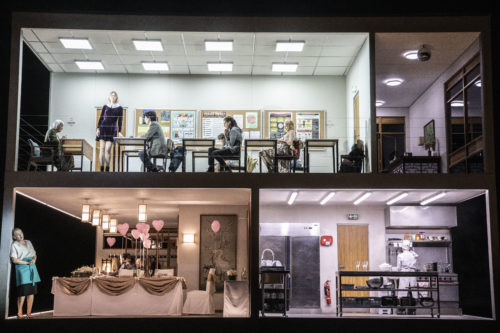
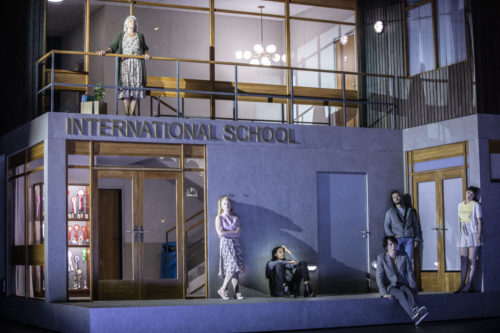

C’est ce que concentre en quelques minutes le superbe prélude orchestral nimbé de mystère qui ouvre et anime progressivement l’espace, de la sonorité rampante du contrebasson aux perspectives lumineuses d’une percussion résonnante et omniprésente dans l’orchestration raffinée de la compositrice. Se dessine au basson, très insinuante, une ligne mélodique aux allures de Leitmotiv qui va hanter obstinément toute la partition. Les figures presque scriabiniennes du hautbois, de la trompette, du violon et du piccolo qui jaillissent de l’orchestre reviendront maintes fois souligner la ligne de chant au cours de l’opéra. A chaque personnage sont attribués une couleur instrumentale et un motif singulier et il faut noter la fonction dramaturgique de la percussion : le registre scintillant des sonneries déjà évoqué et l’importance de la batterie (caisse claire et cymbale) dans les parties rythmiques très incisives où s’insèrent les voix parlées et légèrement traitées par l’électronique. Celle de L’Enseignante, en anglais, s’inscrit au contraire dans un temps long, sur les voix lointaines du chœur et les inflexions théâtrales du Sprechgesang.
Aux différentes strates temporelles du chant et de la parole s’ajoute celle du chœur invisible (magnifique Chœur de chambre estonien), voix amplifiées et spatialisées qui sourdent des profondeurs et modifient l’espace, assurant la liaison d’un monde à l’autre car les scènes se succèdent à une allure quasi cinématographique.
La cheffe Susanna Mälkki est la troisième dame finlandaise impliquée dans cette « fresque » visionnaire, maître d’œuvre exemplaire de la soirée face au London Symphony Orchestra qui ne démérite pas.
Le casting des voix est rien moins qu’exceptionnel, international lui aussi et sélectionné sur mesure, pourrait-on dire, qui fait chanter en tchèque Magdalena Kožená (La Serveuse) ou dialoguer en finnois Jukka Rasilainen (Le Pasteur) et Markus Nykänen (Le Marié) lorsque leurs propos se font plus intimes et surtout plus révélateurs. Sandrine Piau est une Belle-mère sans état d’âme, à la voix claire et bien projetée ; plus nuancé dans ses propos, le baryton-basse Tuomas Pursio (Le Beau-père) déploie une voix souple aux couleurs très expressives face à celle du Pasteur plus résolument ancrée dans son registre de basse. Le ténor Markus Nykänen (Le Marié), au côté de sa fringante épouse (la soprano Lilian Farahani), révèle une voix d’une technique irréprochable qui s’ouvre jusqu’aux ultimes aveux du personnage. Entre révolte et douleur, la mezzo Magdalena Kožená incarne superbement son rôle de mère brisée, victime mais aussi responsable, sinon coupable elle-aussi, aux yeux de la société.
Mise en vedette, inévitablement, aux côtés de ses anciens camarades de classe tous épatants (Beate Modal, Julie Hega, Simon Kluth Camilo Delgado Diaz et Marina Dumont), Vilma Jää (Markéta, la fille disparue) nous fascine à chacune de ses apparitions : voix de l’ange d’un incroyable pouvoir émotionnel dont l’étrange beauté du timbre et les fulgurances vocales nous déconnectent de la réalité. C’est elle qui apporte dans l’épilogue «la petite lueur consolatrice » à cette tragédie qui broie ses victimes et dans laquelle chacun s’identifie.
Croisant les langues, les styles voire les genres, Kaija Saariaho semble aborder avec Innocence une nouvelle étape dans son travail compositionnel. Pour autant, ce cinquième ouvrage lyrique, fruit d’une collaboration fertile entre librettiste et dramaturge, n’en réactive pas moins, avec plus de talent encore, ce « passage des frontières » qu’illustre si brillamment toute la carrière de la compositrice.
Michèle Tosi



)
